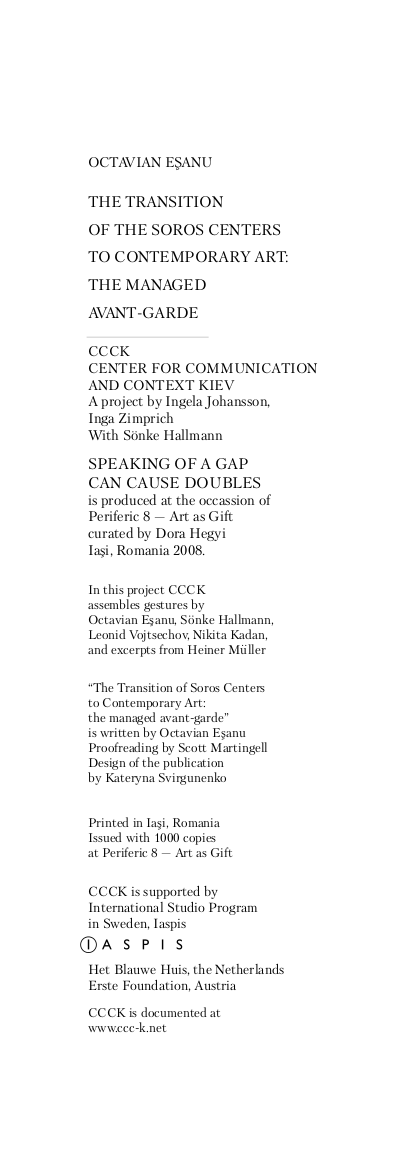Julian Stallabrass: Contemporary Art: A Very Short Introduction (2006)
Filed under book | Tags: · art, art criticism, art system, contemporary art, neoliberalism, politics, postmodern, production

“Bloody toy soldiers, gilded shopping carts, and embroidered tents. Contemporary art is supposed to be a realm of freedom where artists shock, break taboos, flout generally received ideas, and switch between confronting viewers with works of great emotional profundity and jaw-dropping triviality. But away from shock tactics in the gallery, there are many unanswered questions. Who is really running the art world? What effect has America’s growing political and cultural dominance had on art?
Julian Stallabrass takes us inside the international art world to answer these questions, and to argue that behind contemporary art’s variety and apparent unpredictability lies a grim uniformity. Its mysteries are all too easily explained, its depths much shallower than they seem. Contemporary art seeks to bamboozle its viewers while being the willing slave of business and government.”
Publisher Oxford University Press, 2006
Volume 146 of Very short introductions
ISBN 0192806467, 9780192806468
154 pages
PDF (updated on 2015-5-7)
Comment (0)Johansson, Kuznetsov, Zimprich (eds.): Post Funding Eastern Europe (2007) [English/Ukrainian]
Filed under brochure | Tags: · art system, contemporary art, eastern europe

“The Center for Communication and Context (CCCK) has been developed during a residency period in Kiev in August 2006 as a collaboration between Ingela Johansson, Volodymyr Kuznetsov and Inga Zimprich. Within the exhibition Private With Public CCCK started to investigate its host-center’s history, ideological background and future perspectives. Getting involved with a former Soros institution the idea emerged to follow other cases of Soros Centers and to investigate other East-European institutions which were established with the help of or dependant on Western cultural funding. Under the term of Post-funding we would like to expand this project during 2007, researching emerging local financial models and the interdependencies developed in cultural East-West exchange.
Since our first visit to the Center for Contemporary Art, Kiev (CCA) the local situation transformed significantly. With the appearance of the Pinschuk Art Center CCA’s exclusive role to provide a window to and from the West has changed. Given the space to shift its focus CCA is reformulating its program aiming to provide more space for experimentation, research and exhibition practices beyond the merely visual. However, the relevant decision of the Renaissance Foundation whether to support the Center in the future is still pending.” (editors)
Editors: Ingela Johansson, Volodymyr Kuznetsov, Inga Zimprich
Published by CCCK – Center for Communication and Context, Kyiv; and R.E.P. (Revolutionary Experimental Space), Kyiv
28 pages
Licensed under Creative Commons Attribution-ShareAlike 2.5 license
Octavian Eşanu: The Transition of The Soros Centers to Contemporary Art: The Managed Avant-Garde (2008)
Filed under pamphlet | Tags: · art system, contemporary art, eastern europe, institutional critique

“As in other transitological regions of the world, in Eastern Europe, throughout the 1990s, this “neo-liberal discourse of radical reform” became a new ideology. It quickly installed itself in the vacuum left after the collapse of Marxism-Leninism, and its working postulates (directed primarily at politics and economics) soon reached into the domain of art and culture, altering not only pre-established artistic and aesthetic conventions but changing also the social status of art in the post-communist society. While in such fields as politics and economy this doctrine has been recognized and accepted from the very beginning as a legitimate discourse – prompting some scholars to call for “the end of the transition paradigm” – by contrast, in art no analysis has been done on the importance of the notion of “transition” and the impact of transitology. The effect of this paradigm on art, however, was significant. Many individual changes within art resemble the pattern of political and economic reforms to such a degree that one may infer the existence of a “cultural transitology” – a hidden managerial agenda that monitored and implemented reforms in the field of culture. One of the first points on this agenda was the transition to a Western artistic model, and this was one of the main tasks of the SCCAs. One can set a parallel and compare the role of the SCCA network with that played by such active participants in the process of transition as the International Monetary Fund (IMF) and the World Bank. While these international organizations have been concerned in such fields as economics and politics with various aspects of social transformation – disputing such issues as the conversion of planned economies into free markets, or the dissemination of liberal democratic values at the expense of other political doctrines – the SCCAs dealt mainly with the emancipation of art and culture from the ideological, political and economic control of the state. On the aesthetic level this transition was manifested in the attempt to break with the doctrine of Socialist Realism, with its aesthetic and ideological principles; artists were encouraged to work with new media whereas art historians were to write new art histories, which would evolve around the narrative of the formerly suppressed non-conformism. Economically the SCCAs provided expertise for developing local networks of Western styled private and corporate art institutions capable of accommodating to the logic of the free market. After escaping the ideological and material control of the state the centers were to help local artists adjust to a new order, devoting a good part of their efforts to cultural management and fund raising.” (excerpt)
Published by CCCK, Kyiv, at Periferic 8 “Art as Gift” Biennial for Contemporary Art in Iaşi, Romania
20 pages
PDF, PDF (updated on 2019-10-22)
Comment (0)
